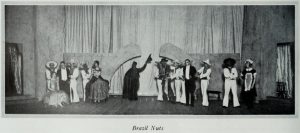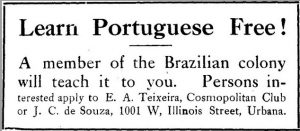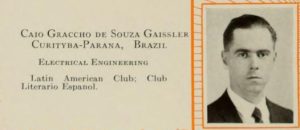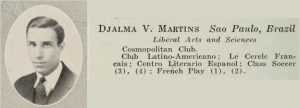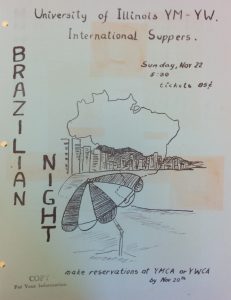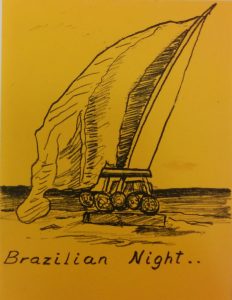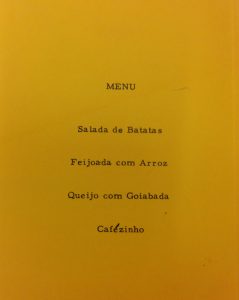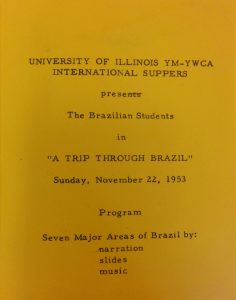Since at least 1914, Brazilian students have been attending the University of Illinois. Early Brazilian Illini have included actors, agricultural economists, agronomists, civil engineers, electrical engineers, mechanical engineers, musicians, physicists, railway civil engineers, and veterinarians too.
Read on to learn more about early Brazilian Illini!
Early Illinois – Brazil Connections
A review of the Board of Trustees proceedings (Record Series 1/1/802) yields multiple instances of emerging connections between the University and the countries of Brazil. Brazilian trade with E. H. Brandt of London, between 1807 and 1842, can be studied in the Emmanuel H. Brandt Collection (Record Series 15/35/50). In 1870, former Mining Engineering Professor Theodore B. Comstock (1885-1889) was First Assistant and Photographer of the Morgan Expedition to Brazil. [1] From 1891 to 1892, later Practical Agriculture Professor (and College of Agriculture Dean) Eugene Davenport (Record Series 8/1/21) was invited to establish and direct the agriculture school Collegio Agronomica in Piracicaba, São Paulo, Brazil. [2] From 1905 to 1909, former Instructor in Dairy Manufacturers and Chief Assistant (1903-1904), Joseph William Hart was Director of the State Model Farm in Sao Paulo, before taking a position in Puerto Rico. [3] In 1906, U.S. Secretary of State Mr. Elihu Root appointed University President James to be a Government Commissioner at the Pan-American Congress in Rio de Janeiro. [4] Former Illinois Entomology Assistant (1899-1900) Edward C. Green of Detroit, Michigan, went on to a variety of university positions across the U.S., before becoming the Director of the Estação Experimental do Algodão, in the state of Maranhão, Brazil in 1913. [5] The Gerard Behague and Everett Helm Latin American Sheet Music Collection (Record Series 12/5/44) provide examples of sheet music for the piano, voice, or violin, including many pieces connected with Carnival. Of course, alumni papers provide even more connections, like the Allen Family Papers (Record Series 41/20/21) which include correspondence regarding agriculture in the state of Minas Gerais, Brazil, during the 1950s and 1960s.
Meanwhile, the faculty connections continued over time. During the early 1950s, 1960s, and 1970s, Geology Professor Ralph E. Grim (Record Series 15/11/27) could be found studying the mineral resources of many countries including Brazil. For academic year 1959-1960, Physical Chemistry Professor Aron Kuppermann took a leave of absence to organize a research group in radiation chemistry at the Brazilian Institute of Atomic Energy in Sao Paulo. [6] In 1961, Spanish Professor Fred P. Ellision traveled to Brazil to research interpretation of social symbols in contemporary Brazilian novels. [7] In 1961, Agriculture Assistant Professor Owen F. Glissendorf took a leave of absence to accept an appointment as International Cooperation Administration extension information adviser in Brazil. [8] During the mid-1960s, the CIC-AID Rural Development Files (Record Series 8/4/40) include work in Brazil too. During Spring 1966, Soil Fertility Professor Edward H. Tyner took a leave of absence to serve as a consultant to the IRI Research Institute of New York in Brazil. [9] Zoology Professor Leverett A. Adams’s (Record Series 15/24/25) research into Latin American fish included significant correspondence with Brazilian colleagues. During the Spring and Summer 1973 terms, History Professor Joseph L. Love was studying the dynamics of Brazilian regionalism from 1889 through 1937. [10] From 1974 through 2016, Economics Professor (1974-2016) and Jorge Lemann Chair in Economics (2001-2013) Werner Baer (Record Series 9/5/41) studied the economies of Latin American and especially Brazil. In 1978, Law Professor John J. Costonis examined the metropolitan planning system of Brazil for application elsewhere. [11]
Early Alumni in Brazil
The earliest alumni to follow careers in Brazil included work in entomology, railroad development and administration, and commerce too. First, Mr. Adolph Hempel, (B.S. 1895), of Canton, Ohio, became an entomologist at Museum Paulista after graduation. [12] In fact, just three years later, Mr. Hemplel became an economic entomologist at the Instituto Agronômico de Campinas. From 1908 until 1917, Mr. Seymour D. Brown (B.S. Civil Engineering, 1904), of North Egremont, Massachusetts, was a secretary and officer manager for the Brazil Railway Company of Port of Para. [13] In 1911, Mr. Frank Theodore Heyle (B.S. Civil Engineering 1909) of Peoria, Illinois, took a position in Porto Belo. [14] Then later Mr. Rolf Harold Josef Gaardner (B.S. Commerce, 1917) of Kristiana, Norway, took a position as Assistant Manager of the Overseas Company of Brazil in Sao Luiz, Maranhao, Brazil in 1919. [15]
Madeira-Mamore Railway
During the early 1900s, many civil engineering graduates found employment working for the development of the Madeira-Mamore Railroad. In fact, at least one undergraduate student committed an entire bachelor’s thesis to a study of the railroad in 1913. Built in the Brazilian state of Rondônia, the Railroad connected Guajará-Mirim to Porto Velho, ultimately providing railway access for goods to pass from eastern Bolivia to western Brazil for shipment across the Atlantic Ocean. Like the Illini who worked on the Panama Canal, these Engineering Illini entered a difficult project which was dangerous too. Many students remained affiliated with the project for a few years while others did not return.
Classes of 1904, 1908, and 1909
The first Illini on the job might have been Mr. Edwin Benjamin Karnopp (B.S. Civil Engineering, 1904), of Lowell, Wisconsin, became a Chief Engineer at Madeira-Mamore Railway, just after graduation. [16] Later came Mr. Theron Robinson Howser (B.S. Civil Engineering, 1908) of Lakota, North Dakota, who was initially a Transitman on the D. L. and W. Railroad before becoming a Resident Engineer on the Madeira-Mamore in 1910. [17] Then came Mr. Lewis Vinton Manspeaker, Jr. (B.S. Civil Engineering, 1909), of Champaign, Illinois who worked for the Railway from 1911 until 1915. [18]
Class of 1910
Mr. Kingsley Abner Burnell, (B.S. Civil Engineering, 1910), of Joliet, Illinois, worked for the Madeira-Mamore Railway from 1910 until 1914. [19] Afterwards, he returned to Joliet, before continuing his studies. Mr. Earl Zink Cornwell (B.S. Civil Engineering), worked for the Madeira-Mamore from 1910 until 1912. [20] Afterwards, he returned to the U.S. working in the state of Washington, Oregon, and later settling in Chicago. Mr. Walter Eugene Lord, (B.S. Civil Engineering) of St. Paul, Minnesota, worked for the Madeira-Mamore from 1910 to 1913. [21] Mr. William Christian Miller, (B.S. Civil Engineering), of Grimsby, England, was a part of the Structural Steel Department of the Railway, from 1911 until 1912. [22] Mr. Leslie Earl Miner, (B.S. Civil Engineering), of Gibson City, Illinois, worked for the Railway from 1910 until 1913. [23] Mr. Henry John Popperfuss (B.S. Civil Engineering), of Tomah, Wisconsin, joined the Railway after graduation in 1910 too. [24] Mr. William James Swisher (B.S. Civil Engineering) worked in Porto Vello from 1911 through 1912. [25]
Class of 1911
Mr. William Selby Allan (B.S. Civil Engineering, 1911) took a position in the Madeira-Mamore Railway in 1912. [26] Mr. Howard William Kaar (B.S. Civil Engineering) joined the Railway Survey of the Madeira-Mamore Railway from 1911 until 1912. [27] Afterwards, Mr. Kaar would return to the United States and work across the country including positions in Indiana, Wisconsin, and New Jersey. Mr. Eugene Frederick Mail (B.S. Civil Engineering) of Robinson, Illinois, worked as an instrument man at the Madeira-Mamore Railway from 1911 until 1912. [28] Afterwards, Mr. Mail returned to U.S. and worked in highway and bridge construction in Marion, Indiana before returning to Robinson until his service in World War I. Mr. Leonard Mauel (B.S. Civil Engineering) of Minneapolis, worked at the Railway too, before taking a Draftsman position in Indiana and later relocating to Chicago. [29]
The Pierrots’ Local Production of “Brazil Nuts”
In 1929, The Pierrots (formerly Illinois Union Dramatic Club) staged a production of new student-written and student-produced opera titled “Brazil Nuts“. For The Pierrots, each fall, students would submit their own creative works in a competition for a spring performance on-campus. In late November 1928, “Brazil Nuts” was selected. By early January 1929, the production was approved for a performance in The Auditorium. But these student performances were not solely for the benefit of the University. In fact, the “Brazil Nuts” show went on a six-city tour around Illinois, including performances in Aurora, Bloomington, Decatur, Quincy, Galesburg, and Peoria. With little time for errors, student production was fast and efficient. In late January, tryouts were arranged. In early February, the cast was selected. Also in February, a call for proposals for program cover design was an opportunity for student graphic designers to show-off their work locally. In early March, tickets went on-sale. In mid-March, student ushers were selected and ticket sales were record-setting. Still, advertisements were published in The Daily Illini of course, and a March 20 interview with the student lyricist was published just a few days before the show on March 20. The first night was “well received”, reported the DI. The show was well-received across Illinois too. In fact, the following year, students produced the show for a second time during Spring 1930. In 1940, a DI reporter wrote that multiple Pierrots shows had been staged in other cities over time, including a production of “Brazil Nuts” at the Palmer House in Chicago.
Directed by J. W. Swanson, written by Douglas Considine (1929) and S. B. Adsit (Law), with music arranged by W. Donahue (1923), the three-act opera is set in a fictional Brazilian cabaret and the garden outside. The plot features an American tourist love triangle interrupted by bandits during a trip in Brazil. For more information, you’ll have to read the non-circulating copy at the Music and Performing Arts Library.
Brazilian Students
Class of 1916
Some of the earliest Brazilian Illini were undergraduates of the Class of 1916. Although, just one year after the Class of 1916 graduated, it should be noted that additional Brazilian students were attending local University High School with the intention of enrolling in Illinois as early as 1917, The Daily Illini reported. Mr. Manoel Ferreira Da Costa (B.S. Electrical Engineering, 1916) was an involved student in the multicultural student organization Cosmopolitan Club. [30] In March 1915, Mr. Da Costa was officially a pledged member. In Le Cercle Francais, he was Treasurer too. While Mr. Licinio Da Silva Couto (B.S. Electrical Engineering, 1916) acted in the student performance of “Huyendo del Perjil” as part of the student-organized “Spanish Night” at Morrow Hall in 1916. [31] And Mr. Marcello Francisco De Lima (B.S. Civil Engineering, 1916) left few records behind. [32]
However, Mr. Jose Cuba de Souza (B.S. Railway Civil Engineering, 1916) left many records of his time in Illinois. [33] While he was a student, the University first offered Portuguese during academic year 1916-1917. Unfortunately, due to low enrollment, the Portuguese program was not renewed and the instructor left after Fall 1916. Fortunately, ambitious students like Mr. de Souza and Mr. Teixeira organized free Portuguese language lessons as quickly as the Fall 1917 term, through the Y.M.C.A.. Even the student organization Latin American Club offered opportunities for students to communicate in both Portuguese and Spanish. When considering later Daily Illini editorials emphasizing pan-American cultural and economic ties, the study of Portuguese might have been oriented towards the study of Brazilian Portuguese from its inception. After graduation, Mr. de Souza took a position with the I. C. Railroad in Memphis, Tennessee.
Class of 1917
Mr. Emilio Alves Teixeira (B.S. Mining Engineer, 1917) of Cassia, Minas, came to Illinois after taking coursework at Syracuse University. [34] In a July 1914 issue of The Daily Illini, Mr. Teixeira wrote an article about recent economic development in Brazil, for readers unfamiliar with the country. But by far, his senior year was a busy year and his most documented year of study too. For a United Charities of Champaign and Urbana organized “Foreign Night”, Mr. Teixeira and nine other foreign students spoke about contemporary issues in their respective nations. Mr. Teixeira gave a talk titled “The Mining Resources of Brazil”. He was captain of the Senior soccer team too. At the same time, Mr. Teixeira was vice-president of Latin American Club. Also that year, he was captain of Cosmopolitan Club soccer team during the intramural soccer season. Not much later, at the national meeting for the national Brazilian Student’s Association meeting, Mr. Teixeira was elected regional vice-president too. After graduation, Mr. Teixeira returned to Brazil where he worked as a mine engineer. The following year, he was an assistant engineer for a mine in Bahia. By 1919, he was working for the Saint John d’EL Rey Mines.
Mr. Paul Cuba de Souza (B.S. Agronomy, 1921), left some records behind too. Mr. de Souza played guitar at the 1917 Spanish Club organized “Spanish Night”. In 1917, he joined Cosmopolitan Club; in 1920, he was president of Cosmopolitan Club. As early as 1917, with fellow Brazilian Illini, Mr. de Souza and others organized some of the earliest Proclamation of the Republic days too. For academic year 1919-1920, Mr. de Souza was the Portuguese secretary for the Latin American Club.
Mr. Djalma V. Martins, (B.A. Liberal Arts and Science, 1921) left some records behind too. For the 1920 Cosmopolitan Club smoker for new students, Mr. Martins sang South American folk songs with other students as part of the musical entertainment. After graduation, Mr. Martins ship went ashore during his voyage to return to Brazil but a British cruiser was able to help evacuate the passengers, The Daily Illini reported.
1950s
Of course there were graduate students too. Some early Brazilian graduate students included Ary Lopes de Almeida (M.S. Physiology, 1952), Valdir Cordeiro Pessoa (M.S. Physiology, 1953), Oscar Calle-Balderrama (M.S. Agricultural Economics, 1955), Eduardo Carlos Tavares Bastos (M.S. Civil Engineering, 1956), Joao Paulo Mendes Penna de Carvalhao (M.S. Civil Engineering, 1956), Alvaro Rubem Marcondes (M.S. Orthodontics, 1956), Abrahao Goldbach (M.S. Civil Engineering, 1956), Claudio Costa Neto (M.S. Chemistry, 1957), Hannelore Loevy (M.S. Pedodontics, 1959; PhD Anatomy, 1961), and Jaime De Azevedo Gusmao Filho (M.S. Civil Engineering, 1959).
1960s
The 1960s saw an increase in graduate students at the campus in Urbana-Champaign campus, with some Brazilian Illini including Sergio Telles Ribeiro (M.S. Electrical Engineering, 1961; PhD Electrical Engineering, 1963), Carlos Jorge Vogel (M.S. Orthodontics, 1961), Eugenio Zerlotti (M.S. Histology, 1962), Sergio Geraldo Quintella (M.S. Mechanical Engineering, 1961; PhD Mechanical Engineering, 1965), Manoel Sobral, Jr. (M.S. Electrical Engineering, 1962; PhD Electrical Engineering, 1964), Francisco Louis Germano (M.S. Physics, 1964), Waldir Marinho Pedersoli, (M.S. Veterinary Medical Science, 1965; PhD Veterinary Medical Science, 1967), Sergio Geraldo Quintella (PhD Mechanical Engineering, 1965), Franca Tagliabue Kuchnir (PhD Physics, 1966), Luiz Gonzaga De Araujo (M.A. Portuguese, 1966), Antonio Roberto Panicali (M.S. Electrical Engineering, 1968; PhD Electrical Engineering, 1971), and Joaquim Severino De Paiva Netto (PhD Mechanical Engineering, 1970).
Organizations
From 1917 through 1922, the Brazilian Student Association produced the publication O Estudante Brasileiro (Record Series 41/64/842). Following Mr. Teixeira’s participation in the December 1916 meeting of the national Brazilian Students’ Association, Illinois became home to the bi-annual publication O Estudante Brasileiro. In November 1917, the first issue was published with Jose de Sampaio (1920) as editor.
Since at least 1917, early Brazilian Illini organized local celebrations of Proclamation of Republic Day (November 15), with venues off campus including Beardsley Hotel (1917) and the Y.M.C.A. (as seen in the Brazilian Night program below).
Are you a Brazilian Illini? Do you know someone who is? We’d like to hear from you! Please send us a message or leave a comment below. We want to include you and your story, as we celebrate the first 150 years of the University of Illinois.
Happy First 150 everyone!
References
[] As always, a special thank you to all students and staff whose tireless work for student life and publications (many of which are available at the University Archives) help preserve the memories of Illini everywhere.
[1] “Theodore B. Comstock”, The Semi-Centennial Alumni Record of the University of Illinois, Edited by Franklin W. Scott, pages 857-858.
[2] “Eugene Davenport”, pages 860-861.
[3] “Joseph William Hart”, page 886.
[4] Meeting of the Board of Trustees of the University of Illinois, March 13, 1906, page 329, Record Series 1/1/802.
[5] Edward S. Green, page 880. For more information about agriculture in the State of Maranhão, please see: Barbosa, Francisco Benedito da Costa, “RELAÇÕES DE PRODUÇÃO NA AGRICULTURA: Algodão no Maranhão (1760 a 1888) e café em São Paulo (1886 a 1929)” Agric. São Paulo, São Paulo, Volume 52, Number 2, pages 17-27, July-December 2005. (Portuguese).
[6] September 16, 1959, page 999.
[7] March 14, 1961, page 417.
[8] September 21, 1961, page 1146.
[9] January 19, 1966, page 1015.
[10] April 18, 1973, page 244.
[11] February 15, 1978, page 532.
[12] “Adolph Hempel”, The Semi-Centennial Alumni Record of the University of Illinois, Edited by Franklin W. Scott, page 85.
[13] “Seymour Dewey Brown”, page 195.
[14] “Frank Theodore Heyle”, page 343.
[15] “Edwin Benjamin Karnopp”, page 204.
[16] “Theron Robinson Howser”, page 314.
[17] “Lewis Vinton Manspeaker, Jr.”, page 351.
[18] “Kingsley Abner Burnell”, page 371.
[19] “Earl Zink Cornwell”, page 372.
[20] “Walter Eugene Lord”, page 386.
[21] “William Christian Miller”, page 389.
[22] “Leslie Earl Miner”, page 389.
[23] “Henry John Popperfuss”, page 393.
[24] “William James Swisher”, page 400.
[26] “William Selby Allan”, page 405-406.
[27] “Howard William Kaar”, page 423.
[28] “Eugene Frederick Mail”, page 428.
[29] “Leonard Mauel”, page 429.
[30] Manoel Ferreira Da Costa, page 614.
[31] Licinio Da Silva Couto, page 614.
[32] Marcello Francisco De Lima, page 632
[33] Jose Cube de Souza, page 698.
[34] Emilio Alves Teixeria, page 700.
[35] Rolf Harold Josef Gaarder, page 716.
